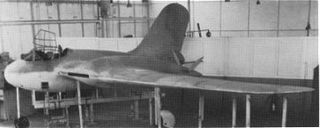
The Messerschmitt Me 328 was originally designed as a parasite aircraft to protect Luftwaffe bomber formations during World War II. During its protracted development, a wide variety of other roles were suggested for it. Late in the war, the design was resurrected for consideration as a Selbstopfer aircraft, but was judged unsuitable even for this purpose. The tiny fighter was to have been propelled by pulsejets, but the unsuitability of these engines doomed the Me 328 from the start.

The Göppingen Gö 9 was a German research aircraft built to investigate the practicalities of powering a plane using a pusher propeller located far from the engine and turned by a long driveshaft.

The Messerschmitt Me 321 Gigant was a large German cargo glider developed and used during World War II. Intended to support large scale invasions, the Me 321 saw very limited use due to the low availability of suitable tug aircraft, high vulnerability whilst in flight and the difficult ground handling, both at base and at destination landing sites. The Me 321 was developed, in stages, into the six-engined Messerschmitt Me 323 Gigant, which removed some of the problems with ground handling, but vulnerability to ground fire and aerial attack remained a constant problem during operations of all variants.

The Junkers Ju 187 was a German projected dive bomber designed to replace the ageing Junkers Ju 87 Stuka. It was cancelled in 1943.

The Braunschweig LF-1 Zaunkönig,, is a STOL single-seat light aircraft designed in 1939 by Prof. Ing. Hermann Winter as a fool-proof trainer for novice student pilots to experience solo flight.

The Henschel Hs 124 was a twin-engine heavy fighter, attack aircraft and light bomber designed in Nazi Germany. After two prototypes had been built, work on the project was cancelled.

The Messerschmitt Me 329 was a design project for a heavy fighter and ground-attack aircraft, developed towards the end of World War II. It was a competitor and possible successor to the Me 410. Like the Me 265, the Me 329 used an advanced flying wing design. Other advanced features included the pilot and navigator sitting in tandem in a broad bubble canopy, and a remote-controlled rear gun in the tail. In spite of the futuristic design, the improvement in performance over the Me 410 was marginal. Development received a low priority, and while a full-scale glider was tested at Rechlin in the winter of 1944/5, work on the project was cancelled shortly after.

The Heinkel He 72 Kadett ("Cadet") was a German single-engine biplane trainer of the 1930s.

The Gotha Ka 430 was a military transport glider, first built in 1944. The glider was designed by Albert Kalkert. Twelve had been produced by the end of World War II, but none of them was used operationally.

The Heinkel HD 42 50, later designated the Heinkel He 42 was a German two-seat biplane seaplane originally designed for the Deutsche Verkehrsfliegerschule, and later built for the German Luftwaffe. The aircraft was used until the end of World War II as a trainer for maritime pilots.

The Hopfner HA-11/33 was an amphibious flying boat built in Austria in 1933 to a specification by the Dr. Oetker company. The result was a conventional, high-wing cantilever monoplane with a stepped flying boat hull and pontoons on struts under the wings at mid-span. The cabin was fully enclosed, and the twin engines were mounted tractor-fashion on struts above the wing.

The Heinkel He 49 was a German single-bay, single-seat biplane of mixed construction armed with two machine guns. Four variants were made, the He 49a, He 49b, He 49c.

The Blohm & Voss P 194 was a German design for a mixed-power Stuka or ground-attack aircraft and tactical bomber, during World War II.
The Baumgärtl Heliofly III/57 and Baumgärtl Heliofly III/59 were 1940s experimental backpack helicopters designed and built by the Austrian-designer Paul Bäumgartl. Following on from his earlier experiments with strap-on autgyros the Heliofly III/57 was powered by two 8 hp (6 kW) Argus As 8 piston engines each driving a single-blade of the contra-rotating rotors.
The Messerschmitt P.1092 was a series of Messerschmitt experimental aircraft for the Luftwaffe during the Second World War. Several designs for single- and twin-engined aircraft were drafted under the same designation.

The Albatros L102 / Albatros Al 102, was a German trainer aircraft of the 1930s. It was a parasol-wing landplane, seating the student pilot and instructor in separate, open cockpits. A biplane floatplane version was also built as the Al 102W, with strut-braced lower wings.
The Albatros L 103 / Albatros Al 103 was a German experimental aircraft of the 1930s. It was a parasol-wing landplane of conventional configuration, seating the pilot and flight test observer in separate, open cockpits. The Al 103 was used to test variations in sweepback, dihedral and tailplane area.

The Hamburger Flugzeugbau Ha 135 was the first aircraft produced by the new aircraft subsidiary of the German company Blohm & Voss.
The Heinkel P.1080 was a proposed Emergency Fighter powered by two ramjet engines.















